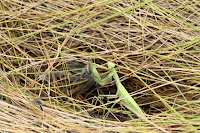Praying or European mantis (Mantis religiosa) is the most
common mantid on the salt marsh. As the name suggests, it is an introduced
species that came to the US
The last wild frontier - the salt marsh, and the creatures that call it home
Aug 13, 2012
August - the battle of two predators 2
Aug 3, 2012
Parasitoids - the truely tiny
Parasitoids, or insect consuming other insect but in moderation (usually just one) are frequently overlooked due to their small size, like a flying spec of dust. These tiny wasps search for eggs or small insects as a food source for their larvae.
End of July - The battle of two predators 1
Seaside dragonlet is among the most beautiful insects on the salt marsh. It is also among its deadliest. As an immature, which is called naiad for dragonflies, it is the top invertebrate predator in the potholes and on the mudflats, a hunter of other creatures.
As an adult, seaside dragonlet eats whatever it can catch, mostly flies - mosquitoes, midges, syrphids and similar. But, the marsh surface is also a home to another deadly creature, the spider. Spiders are mostly generalist predators and take whatever comes their way, which usually means the most abundant insects at the moment. This year it's been dragonflies buzzing around in enormous swarms. Sadly, many ended up in the spider nets protruding from the salt marsh vegetation...
As an adult, seaside dragonlet eats whatever it can catch, mostly flies - mosquitoes, midges, syrphids and similar. But, the marsh surface is also a home to another deadly creature, the spider. Spiders are mostly generalist predators and take whatever comes their way, which usually means the most abundant insects at the moment. This year it's been dragonflies buzzing around in enormous swarms. Sadly, many ended up in the spider nets protruding from the salt marsh vegetation...
Subscribe to:
Comments (Atom)
















